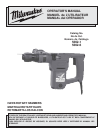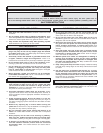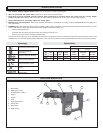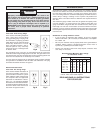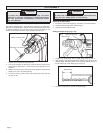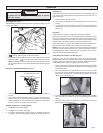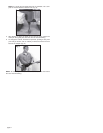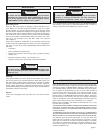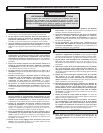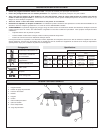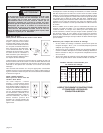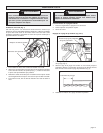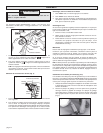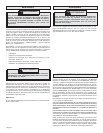
page 7
OPERATION
To reduce the risk of injury, wear safety goggles or glasses
with side shields.
WARNING!
Selecting Action (Fig. 4)
MILWAUKEE Hawk Rotary Hammers have two settings: drilling or ham-
mering with rotation.
1. For drilling, turn the hammer/drill collar so that the twist drill symbol
lines up with the arrow on the chuck collar.
2. For hammering with rotation, turn the hammer/drill collar so that the
hammer symbol lines up with the arrow on the chuck collar.
NOTE: To engage the hammering mechanism, maintain pressure on
the bit. When pressure on the bit is released, the hammering action
will stop.
Using the Forward/Reverse Switch (Fig. 5)
Fig. 5
Forward/Reverse switch
Forward
Reverse
1. For forward (clockwise) rotation, push the forward/reverse switch to
the left.
2. For reverse (counterclockwise) rotation, push the forward/reverse
switch to the right. An interlock prevents switching to reverse while
pulling the trigger. To prevent damage to the gears and motor, allow
the tool to coast to a full stop before reversing.
Starting, Stopping & Controlling Speed
1. To start the tool, pull the trigger.
2. To stop the tool, release the trigger.
3. To vary the driving speed, simply increase or decrease pressure on
the trigger. The further the trigger is pulled, the greater the speed.
Cold Starting
If this tool is stored for a long period of time or at cold temperatures, it
may not hammer initially because the lubrication has become stiff. To
warm up the tool:
1. Insert and lock a bit into the tool.
2. Turn the tool on, applying force to the bit against a concrete or wood
surface.
3. Turn the tool on and off every few seconds. In a short time, the tool
will start hammering. The colder the tool is, the longer it will take to
warm it up.
Operating
Position the tool, grasp the handles firmly and pull the trigger.
Always hold the tool securely using both handles and maintain control.
Use only enough pressure to hold the tool in place and prevent the tip of
the bit from wandering. This tool has been designed to achieve top per-
formance with only moderate pressure. Let the tool do the work.
If the speed begins to drop off when drilling deep holes, pull the bit par-
tially out of the hole while the tool is running to help clear dust.
NOTE: Do not use water to settle the dust since it will clog the bit flutes
and tend to make the bit bind in the hole. If the bit should bind, a built-in,
non-adjustable slip clutch prevents the bit from turning. If this occurs,
stop the tool, free the bit and begin again.
Using Rotary Percussion Core Bits (Fig. 6-9)
Core bits are useful for drilling large holes for conduit and pipe.
MILWAUKEE Heavy-Duty Core Bits have heat-treated steel bodies with
durable carbide tips. These core bits are specially designed for fast, ac-
curate drilling with combined hammering and rotary action.
1. Clean and lubricate the threads on the adapter and core bit to make
later removal easier. Screw the threaded end of the adapter into the
rear of the core bit.
2. Push the guide plate onto the pointed end of the center pin. Insert
the center pin and guide plate assembly into the core bit. Be sure the
small end of the center pin is securely placed into the hole in the
center of the core bit (Fig. 6).
Fig. 6
3. Insert the adapter into the nose of the tool as described in “Installing
Bits”. Set the stop rotation knob to the hammering-with-rotation
setting.
4. Press the center pin firmly against your center mark, hold the tool
firmly and pull the trigger (Fig. 7).
Drill
Hammer
Arrow
Fig. 4
Hammer/
Drill
Collar
Chuck Collar
Fig. 7



